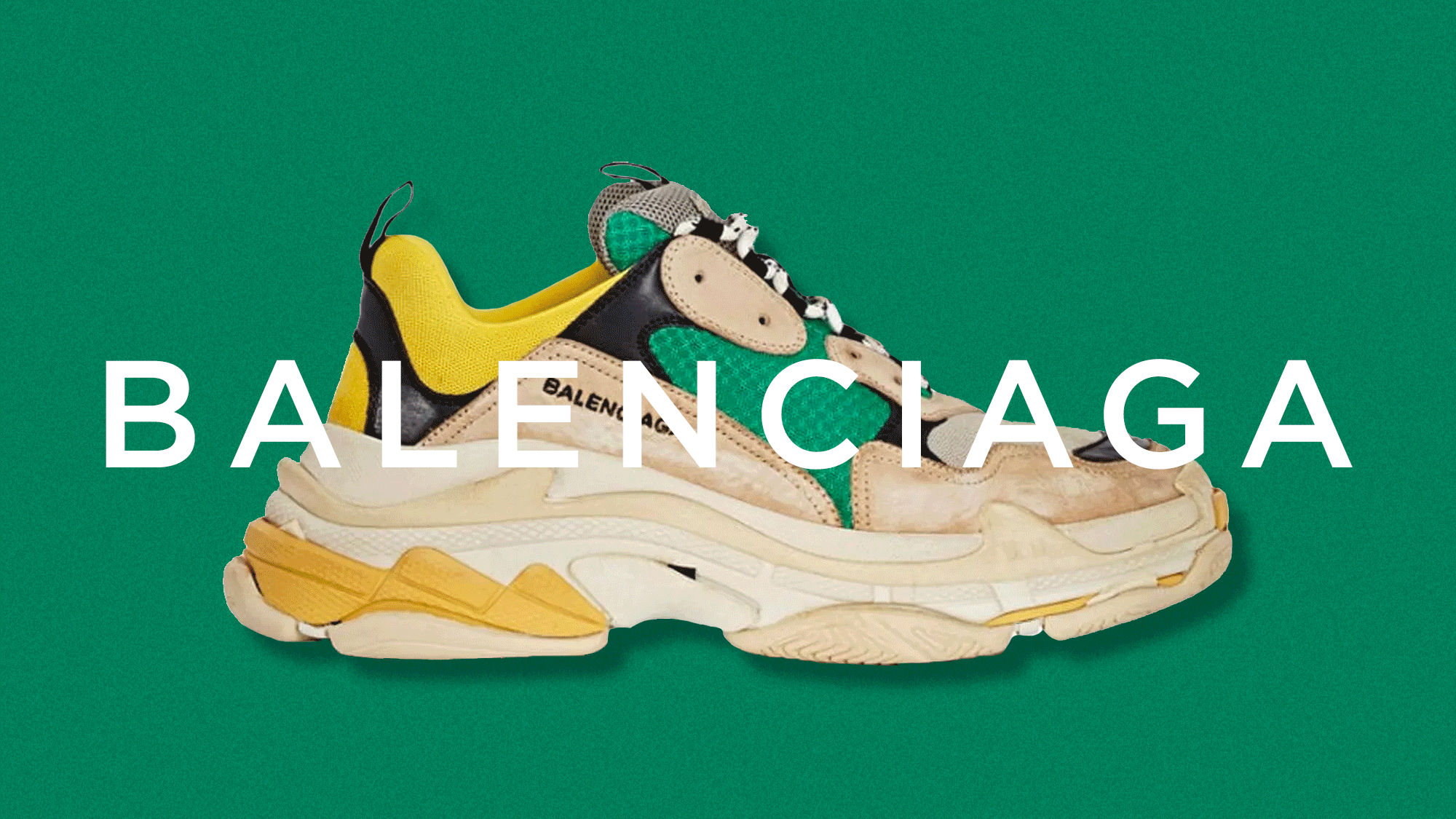Earlier this month, while lazily scrolling through my Instagram Stories feed, a slyly placed ad appeared. Set against an all-white background was a pair of pristine Balenciaga Triple S sneakers—the pièce de résistance of Demna Gvasalia’s fall 2017 Balenciaga collection, an ugly sneaker to rule them all—and above it the announcement of an unbelievable sale: this $850-plus sneaker was available for less than half that price. The sponsored post, served to me from an account calling itself “Balenciaga,” seemed legitimate enough.
I swiped up—Instagram Stories is a safe space, right? Maybe you would’ve realized that the plain webpage I was whisked away to was not in fact balenciaga.com, but balenciaga-mall.com, a weeks-old site that originated somewhere in Kansas. I didn’t, and instead bookmarked it, deciding to buy myself a pair at the end of the work day. And I almost followed through, until a coworker pointed out that the website looked...dubious: The “about us” page was lifted word-for-word from Balenciaga’s Wikipedia page.
As long as there have been luxury goods, there have been knockoffs of luxury goods. But the impulses that pushed me toward these fake sneakers speak to this particular moment in fashion, when the business of luxury hoaxes and fakes moves at hyperspeed. The designer of those Balenciagas seems to be engaged in a large-scale practical joke about what counts as luxury, Instagram stories has turned into an advertising thunderdome, and the factories that make fake sneakers are closer than ever to nailing the real thing. All of which adds up to this: it is easier than ever to be a participant, witting or unwitting, in the world of black-market sneakers.
In the weeks since nearly getting duped, my Instagram Stories feed, as well as those of friends and acquaintances, has been inundated with posts advertising insane sales. The promise of half-off grails nips at me wherever I go. Sure, the Internet’s always been designed for fantasy scams, from flashing banners to those weight-loss Facebook ads that stalk you around the web. But hawking knock-off hyperluxe sneakers on Instagram seems especially insidious, because high-ticket items like the Triple S are heart-click gold on social media. Instagram is where we go to see celebrities flexing in Triple Ss—and now, to be sold our own, too.
On Instagram, the sale and circulation of fake luxury goods constitutes an enormous shadow economy. A 2016 study conducted by a team of World Economic Forum security researchers concluded that about one-fifth of Instagram posts tagged with luxury items were fake, funneling users to counterfeit sellers or outright phishing operations. According to the Washington Post, Instagram facilitates the sale of about $29 billion in counterfeit goods. That’s only a fraction of the total $461 billion counterfeit goods industry, but it’s significant, not least because Instagram is tailor-made to make us want things.
“It's the perfect tool for shilling stuff,” says David Pierson, an L.A. Times technology journalist. “Instagram gives anyone the means to make highly-polished, catalog-worthy photos.” The Stories feed in particular is a uniquely vulnerable place for users, where mindless swiping through 24-hours-only posts makes us susceptible to advertiser sleights of hand. In December, for example, an Instagram user named Blake Robbins noticed a Story ad for a fake-looking Black Friday sale on Yeezy sneakers, with a stray hair digitally doctored onto the post. You, naive user, think the strand has fallen from your own head, so you swipe it off—and get redirected to a page for a suspect clearance sale. And since this counts as an ad impression as well, it’s likely some clever digital marketer is getting paid by the store for each user who wanders in, whether they buy shoes or not.
The more you interact with certain kinds of ads on Instagram (and its parent site, Facebook), the higher the likelihood that the site’s algorithm will serve you similar content. An Instagram spokesperson told me that the ads I was seeing in my feed were approved by mistake, and subsequently “reviewed them again and removed them for future delivery.” Through a combination of automated and manual processes, Instagram says it reviews and approves all ads. But scammers are dedicated. Scouting millions of posts, sometimes churned out by sophisticated bot networks, makes catching every bad actor impossible. The worry that Instagram and Facebook track our every move, chaperoning us to transactions and decisions to satisfy our id, is a real concern. And the stakes can be great: a carefully placed post can cause a riot.
On a significantly smaller scale, an ad can dupe us into buying fugazi sneakers: Instagram Stories is perfectly geared to deliver offers that seem too good to be true. But in the upside-down world of modern fashion—and especially in the madcap mind of Balenciaga designer Demna Gvasalia—words like “good” and “true” don’t quite mean what they used to.
When Balenciaga introduced the Triple S last year, the shoe blurred the boundaries between brash streetwear and staid high-fashion houses. It was the ultimate coup-de-grace from designer Demna Gvasalia. Between his work at Vetements and Balenciaga, he’s elevated irony and trolling into art: his riffs on totems like the Ikea bag and the Bernie Sanders campaign logo are as much about mocking high fashion as our own expectations for expensive, brand-name clothing. The Triple S is both his most comical and most critical item. It looks like the product of a computer glitch or factory mishap, a mish-mash of parts that simultaneously evokes orthopedic dad shoes and hypebeast-friendly kicks. It’s striking, almost impossible to wear, and begs to be publicized. Which makes it the perfect idol for our ‘grammed-to-hell fashion culture.
Then those scam ads roll, and the seductive call of cheap luxury apparel forces you to ask yourself: How much do you want what the kids in Supreme hoodies and Kurt Cobain glasses call clout? Are you willing to do whatever it takes to get the Triple S on your feet? Even if that means...not putting real Triple Ss on your feet? The latter avenue isn't hard to follow: if I really want to indulge my fantasy of purchasing Triple Ss in Grey/Red/Blue at a heavily discounted price, I just have to head to the subreddit Repsneakers (short for “Replica Sneakers”).
The 73,094 subscribers to the forum share intel, advice, pictures, and opinions on replica sneakers typically purchased from Chinese factories. Using Instagram, WeChat, or WhatsApp, a curious buyer can liaise with middlemen bearing non-descript names like Uncle Lin or Eric, and connect with a whole host of merchants who specialize in manufacturing near-perfect replicas of the latest sneakers. The entire process is meticulous and streamlined: merchants send quality-control pictures of the knock-offs sneakers, and Western Union handles the cash transaction.
A 30-year old RepSneaker regular I’ll call James told me he was compelled to look into the rep community after he fell in love with the “Pirate Black” Yeezy 350 Boosts, but found the resale prices to be “ridiculous.” In the year since he’s started purchasing replicas, he’s been able to compare his buys to authentic pairs, and thinks in terms of looks, quality, and comfort, there is “literally no difference” between the fake and the real. (Triple Ss from his preferred site run under $200.) He now owns Yeezy and Triple S replicas too, which he says “are pretty damn close and are super comfy.” James says he prefers to buy authentic, so why wade into the ultra-murky waters of knock-offs? My guess: a personal supply line is a pleasure and power all its own.
The rising quality and preponderance of replicas, along with the increasing difficulty of the untrained (and trained) eye to spot fake from real, has created what some sneakerheads consider an almost philosophical crisis. Times reporter Pierson says that as replicas get better, we’ll eventually be faced with an existential question about fakes: “If counterfeiters are using the same materials that official manufacturers use, and possess nearly the same level of craftsmanship, who's to say what's real and what's fake?”
The resale market—the beating heart of the clout-obsessed, Instagram-beholden, hypebeast-powered sneaker economy—relies on inspectors to make sure that product stays honest, but even authenticators are getting fooled, according to posters on RepSneakers. Balenciaga even moved production of the Triple S from Italy to China in January. Presumably, quality isn’t the issue. (Representatives at Kering, Balenciaga’s parent company, did not respond to requests for comment on this story.)
A number of famous sneakerheads, like the 20-year old YouTuber Yeezy Busta, are committed to making sure the replica wearers of the world, especially the famous ones, get called out. Yeezy Busta claims his goal is “educational”: to make the wearing of “fake goods” a “socially unacceptable” act, as hazardous as cigarette smoking. But while he’s concerned about fakes being mistaken for the real thing, the world of Internet knockoffs carries deeper risks. Researchers confirm that some portion of the counterfeit economy ends up in the hands of criminal organizations and factories for reps have been found to be badly unregulated. The ethics of high-fashion, of deadstock sneakers and perfect fakes, are complicated and contradictory. Choosing to enter the counterfeit economy is, in some sense, about leveling the playing field.
A few weeks after I first encountered the Instagram ads, while I was still daydreaming about my cheap Triple Ss, , New York Times music critic Jon Caramanica posted a picture of a pair of truly wild sneakers: a chunky shoe with the same silhouette of the Triple S, only somehow made even uglier and cheaper. On its side, the extremely bootleg-looking sneaker claimed to be of the “KanyeYeezy” brand. This was a new kind of fake. A confident fake.
“Luxury is not affordable for everybody, so I've always been enamored with informal designers or bootleggers who took luxury into their own hands and made versions of it that are more democratic,” says Caramanica. Using a replica marketplace, he found a shoe so mixed-up in its signifiers that it speaks to this confusing fashion moment perfectly.
Marc Dolce left Nike for Adidas in 2014—and is just getting started on envisioning the future of the Three Stripes.

“Is it any different for me to wear these KanyeYeezy whatevers,” he asks, “than from what Demna [Gvasalia] makes—like a $1200 logo sweatshirt that's basically bootleg?” In 2018, as fake and real blur into a messy gray area, as the sneaker market is beset by Bitcoin-like inflations, and as bad deals hide next to your friends’ Instagrams, what counts as a good deal? What's the difference between an actual luxury good and the futuristic simulacrum of one? From this angle, the fake Triple S is an even more perfect Demna object—a piece of clothing whose punchline goes farther than even its creator intended.
In a recent interview, Miuccia Prada reflected on fashion’s authenticity problem: “Today everybody is inventing their lives; it’s all embellishment and upgrading. No one tells the truth—I think that’s why we long for authenticity.” It’s possible this has always been true of fashion. But social media has accelerated, in all parts of culture, the inability to tell fact from fiction. And perhaps the best way to tackle the hype cycle is to muck it all up and embrace the confusion. Those bootleg Triple Ss haunting my dreams look better and better every day.







